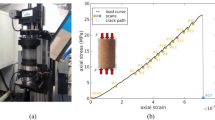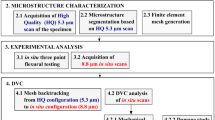Abstract
Spherical indentation of granite was investigated using Digital Volume Correlation (DVC) aiming at probing constitutive laws of the studied rock. In situ indentation was performed within an X-ray tomograph. Finite element simulations of the problem, using different constitutive models, were carried out and their trustworthiness was assessed thanks to DVC residuals. Three laws were investigated, namely, pure elasticity, then compressible elastoplasticity, and finally compressible elastoplasticity coupled with damage. Frictional contact effects were studied as well. The results show that compressible elastoplasticity should be accounted for to achieve high accuracy of results, and that frictional effects are of importance in terms of damage extent. If macrocrack initiation is also sought, then damage features should be included in the model.
Highlights
-
Spherical indentation of granite was investigated using Digital Volume Correlation.
-
Different constitutive laws were probed and their trustworthiness assessed thanks to registration residuals.
-
Compressible elastoplasticity is to be accounted for to obtain faithful results.
-
Frictional effects are of importance in terms of damage extent.
-
Macrocrack initiation was described with a damage model.



















Similar content being viewed by others
References
Abaqus analysis user’s manual version 6.14-2
Abramowitz M, Stegun IA (1965) Handbook of mathematical functions. Dover Publications Inc, New York (USA)
Bay BK (2008) Methods and applications of digital volume correlation. J Strain Anal Eng Des 43:745–760
Bouterf A, Adrien J, Maire E, Brajer X, Hild F, Roux S (2017) Identication of the crushing behavior of brittle foam: from indentation to oedometric tests. J Mechan Phys Solids 98:181–200
Bouterf A, Maire E, Roux S, Hild F, Brajer X, Gouillart E, Boller E (2018) Analysis of compaction in brittle foam with multiscale indentation tests. Mech Mater 118:22–30
Bouterf A, Roux S, Hild F, Adrien J, Maire E, Meille S (2014) Digital Volume Correlation Applied to X-ray Tomography Images from Spherical Indentation Tests on Lightweight Gypsum. Strain 50(5):444–453
Buljac A, Jailin C, Mendoza A, Neggers J, Taillandier-Thomas T, Bouterf A, Smaniotto B, Hild F, Roux S (2018) Digital volume correlation: review of progress and challenges. Experim Mechan 58(5):661–708
Cai B, Karagadde S, Marrow TJ, Connolley T, Lee PD (2015) Synchrotron X-ray tomographic quantification of deformation induced strain localisation in semi-solid Al- 15wt%Cu. IOP Confer Series Mater Sci Eng 84:012079
Cai B, Lee PD, Karagadde S, Marrow TJ, Connolley T (2016) Time-resolved synchrotron tomographic quantification of deformation during indentation of an equiaxed semi-solid granular alloy. Acta Materialia 105:338–346
Carlsson S, Biwa S, Larsson P-L (2000) On frictional effects at inelastic contact between spherical bodies. Int J Mech Sci 42(1):107–128
Davies DGS (1973) The statistical approach to engineering design in ceramics. Proc Brit Ceram Soc 22:429–452
Denoual C, Hild F (2002) Dynamic fragmentation of brittle solids: a multi-scale model. Eur J Mech Solids 21(1):105–120
Drucker DC, Prager W (1956) Soil mechanics and plastic analysis of limit design. Quat Appl Math 14:157–165
Forquin P, Hild F (2010) A probabilistic damage model of the dynamic fragmentation process in brittle materials. Adv Appl Mech 44:1–72
Hild F, Bouterf A, Chamoin L, Mathieu F, Neggers J, Pled F, Tomičević Z, Roux S (2016) Toward 4d mechanical correlation. Adv Model Simul Eng Sci 3(1):1–26
Lacondemine T, Réthoré J, Maire E, Célarié F, Houizot P, Roux-Langlois C, Schlepütz CM, Rouxel T (2019) Direct observation of the displacement field and microcracking in a glass by means of X-ray tomography during in situ Vickers indentation experiment. Acta Materialia 179:424–433
Leclerc H, Neggers J, Mathieu F, Hild F, Roux S(2015) Correli 3.0. IDDN.FR.001.520008.000.S.P.2015.000.31500, Agence pour la Protection des Programmes, Paris (France)
Lemaitre J (1992) A Course on Damage Mechanics. Springer-Verlag, Berlin (Germany)
Lu X, Peña Fernández M, Bradley RS, Rawson SD, O’Brien M, Hornberger B, Leibowitz M, Tozzi G, Withers PJ (2019) Anisotropic crack propagation and deformation in dentin observed by four-dimensional X-ray nano-computed tomography. Acta Biomaterialia 96:400–411
Ma L, Fauchille A-L, Chandler MR, Dowey P, Taylor KG, Mecklenburgh J, Lee PD (2021) In-situ synchrotron characterisation of fracture initiation and propagation in shales during indentation. Energy 215:119161
Maire E, Withers PJ (2014) Quantitative X-ray tomography. Int Mater Rev 59(1):1–43
Mazars J (1986) A description of microscale and macroscale damage of concrete structures. Eng Fract Mech 25(5–6):729–737
Mostafavi M, Bradley R, Armstrong DEJ, Marrow TJ (2016) Quantifying yield behaviour in metals by X-ray nanotomography. Scient Rep 6:34346
Mostafavi M, Collins DM, Cai B, Bradley R, Atwood RC, Reinhard C, Jiang X, Galano M, Lee PD, Marrow TJ (2015) Yield behavior beneath hardness indentations in ductile metals, measured by three-dimensional computed X-ray tomography and digital volume correlation. Acta Materialia 82:468–482
Mostafavi M, Vertyagina Y, Reinhard C, Bradley R, Jiang X, Galano M, Marrow J (2014) 3D Studies of indentation by combined x-ray tomography and digital volume correlation. Mater Str Micromech Fract VII Key Eng Mater 592:14–21
Saadati M, Forquin P, Weddfelt K, Larsson P-L, Hild F (2014) Granite rock fragmentation at percussive drilling - experimental and numerical investigation. Int J Numer Anal Methods Geomech 38(8):828–843
Saadati M, Forquin P, Weddfelt K, Larsson P-L, Hild F (2015) A numerical study of the influence from pre-existing cracks on granite rock fragmentation at percussive drilling. Int J Numer Anal Methods Geomech 39(5):558–570
Saadati M, Forquin P, Weddfelt K, Larsson P-L, Hild F (2017) On the mechanical behavior of granite material with particular emphasis on the influence from pre-existing cracks and defects. J Testing Eval 46(1):33–45
Saadati M(2015) On the mechanical behavior of granite: Constitutive modeling and application to percussive drilling. Doctor Dissertation, KTH Royal Institute of Technology
Saucedo-Mora L, Mostafavi M, Khoshkhou D, Reinhard C, Atwood R, Zhao S, Connolly B, Marrow TJ (2016) Observation and simulation of indentation damage in a SiC-SiC\(_{fibre}\) ceramic matrix composite. Finite Elements Analysis Design 110:11–19
Shariati H, Saadati M, Bouterf A, Weddfelt K, Larsson PL, Hild F (2019) On the inelastic mechanical behavior of granite: study based on quasi-oedometric and indentation tests. Rock Mech Rock Eng 52:645–657
Shariati H, Saadati M, Weddfelt K, Larsson P-L, Hild F (2019) A damage model for granite subjected to quasi-static contact loading. Int J Numer Analyt Methods Geomech 46(2):374–391
Shariati H, Saadati M, Weddfelt K, Larsson P-L, Hild F (2020) Study of frictional effects of granite subjected to quasi-static contact loading. Lubricants 8(12):106
Souissi S, Miled K, Hamdi E, Sellami H (2017) Numerical modeling of rock damage during indentation process with reference to hard rock drilling. Int J Geomech 17:04017002
Tkalich D, Fourmeau M, Kane A, Li CC, Cailletaud G (2016) Experimental and numerical study of Kuru granite under confined compression and indentation. Int J Rock Mechan Min Sci 87:55–68
Vertyagina Y, Mostafavi M, Reinhard C, Atwood R, Marrow TJ (2014) In situ quantitative three-dimensional characterisation of sub-indentation cracking in polycrystalline alumina. J Eur Ceram Soc 34(12):3127–3132
Weibull W(1939) A statistical theory of the strength of materials. Technical Report 151, Roy Swed Inst Eng Res
Acknowledgements
The authors would like to thank Dr. Kenneth Weddfelt at Epiroc Rock Drills AB for helpful discussions. This work was partially funded by Agence Nationale de la Recherche under grant ANR-10-EQPX-37 (MATMECA) and by Epiroc Rock Drills AB.
Author information
Authors and Affiliations
Corresponding author
Ethics declarations
Conflict of interest
The authors declare that they have no conflict of interest.
Additional information
Publisher's Note
Springer Nature remains neutral with regard to jurisdictional claims in published maps and institutional affiliations.
Appendices
Appendix A: DVC Hardware Parameters
Tomograph | North Star Imaging X50+ |
|---|---|
X-ray source | XRayWorX XWT-240-CT |
Target / Anode | W (reflection mode) |
Filter | None |
Voltage | 140 kV |
Current | 220 µA |
Focal spot size | 5 µm |
Tube to detector | 938 mm |
Tube to object | 192 mm |
Detector | Dexela 2923 |
Definition | \(1536\times 1944\) pixels (\(2\times 2\) binning) |
Number of projections | 1000 |
Angular amplitude | 360° |
Frame average | 25 per projection |
Frame rate | 7 fps |
Acquisition duration | 1 h 24 min |
Reconstruction algorithm | Filtered back-projection |
Gray Levels amplitude | 8 bits |
Volume size | \(811\times 808\times 707\) voxels (after crop) |
Field of view | \(25\times 25\times 22\) mm\(^3\) (after crop) |
Image scale | 30.8 µm/voxel |
Pattern | Natural (Fig. 2) |
Appendix B: Constitutive Laws
In this appendix, the three investigated constitutive models are detailed. The last two models required user defined subroutines to be implement within the explicit version of Abaqus.
1.1 Elasticity (E)
Isotropic elasticity is assumed. The Cauchy stress tensor \(\pmb {\sigma }\) is related to the elastic strain tensor \(\pmb {\epsilon }^e\) by
where E denotes the Young’s modulus, \(\nu\) the Poisson’s ratio, and \(\mathbf{{1}}\) the second order identity tensor. In elasticity, the elastic strain tensor \(\pmb {\epsilon }^e\) is equal to the infinitesimal strain tensor \(\pmb {\epsilon }\).
1.2 Elastoplasticity (EP)
Since the strain levels are assumed to remain small, the strain tensor is additively partitioned into elastic and inelastic parts
where \(\pmb {\epsilon }^i\) denotes the inelastic strain tensor. The Drucker-Prager (1956) yield function \(F_y\) reads
where q is von Mises’ equivalent stress, p the hydrostatic pressure (i.e., \(p=-1/3(\pmb {\sigma }:\mathbf{{1}})\)), d the cohesion, and \(\beta\) the friction angle.
The flow potential reads
where \(\psi\) is the dilation angle (Shariati et al. 2019)
\({\dot{\epsilon }}^i_a\) the inelastic axial strain rate, and \({\dot{\epsilon }}^v_a\) the inelastic volumetric strain rate.
1.3 Elastoplasticity Coupled with Damage (EPD)
The previous model essentially describes the behavior in compressive (i.e., confined) states. In the present case, it is activated in the immediate vicinity of the indentation zone (Shariati et al. 2019, 2020). Farther away from this compacted zone, cracks may initiate due to tensile stresses (Shariati et al. 2019). To describe the early stages of such mechanism, the so-called DFH model is considered (Denoual and Hild 2002; Forquin and Hild 2010) and coupled with the previous one. It was already applied in the study of dynamic fragmentation of Bohus granite (Saadati et al. 2014, 2015; Shariati et al. 2020).
An anisotropic damage model is considered. In the principal frame, the compliance tensor of damaged elements becomes
and the growth law of each damage variable \(D_i\) associated with principal stress \(\sigma _i\) reads
with
where \({\widetilde{\sigma }}_i\) is the i-th effective principal stress (i.e., \({\widetilde{\sigma }}_i = \sigma _i/(1-D_i)\), with no index summation), \(V_{\mathrm {FE}}\) the volume of the considered finite element, m and \(\sigma _0^m/\lambda _0\) the Weibull parameters (Weibull 1939), \(C_0\) the longitudinal wave speed so that the crack propagation velicity is \(kC_0\) (with \(k=0.38\)), and \(S=3.74\) the dimensionless shape parameter of the relaxation zones (Saadati et al. 2015). The stress \(\sigma _k\) is randomly selected for each finite element as the initiation level for the first crack according to the Weibull model
where \(P_k\) denotes the initiation probability, which is randomly selected in a uniform distribution ranging from 0 to 1. If the weakest link hypothesis applies, the initiation probability is equal to the cumulative failure probability of the considered element
and the corresponding mean failure stress becomes
where \(\Gamma\) is the Euler function of the second kind (Abramowitz and Stegun 1965). If the failure probability of the whole structure is to be evaluated, the volume \(V_{\mathrm {FE}}\) of any element has to be replaced by the effective volume \(V_{\mathrm {eff}}\) (Davies 1973).
Rights and permissions
About this article
Cite this article
Shariati, H., Bouterf, A., Saadati, M. et al. Probing Constitutive Models of Bohus Granite with In Situ Spherical Indentation and Digital Volume Correlation. Rock Mech Rock Eng 55, 7369–7386 (2022). https://doi.org/10.1007/s00603-022-02991-9
Received:
Accepted:
Published:
Issue Date:
DOI: https://doi.org/10.1007/s00603-022-02991-9




